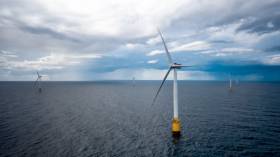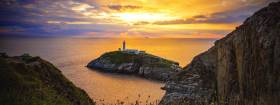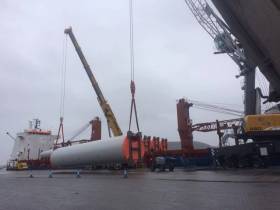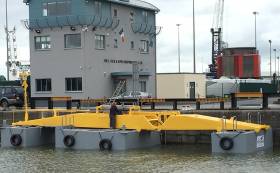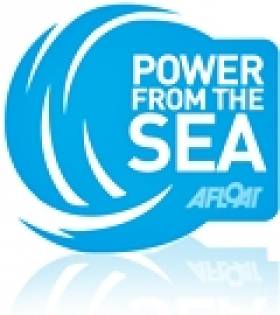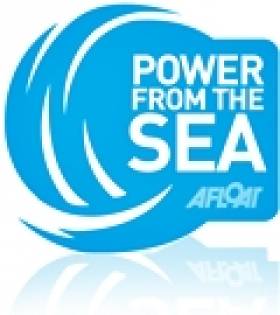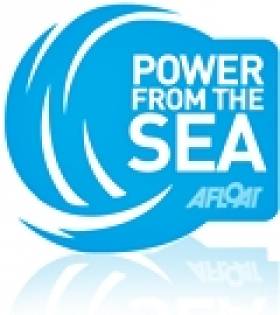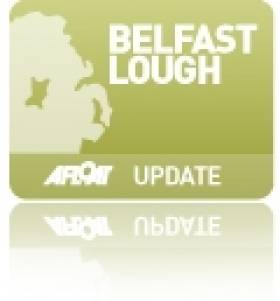Displaying items by tag: renewable energy
World’s First Floating Windfarm Now Powering Scotland
#Windfarm - The world’s first floating windfarm is now generating power for Scotland, according to BBC News.
Afloat.ie previously covered the Hywind Scotland project, backed by Norwegian energy giant Statoil, which comprises a series of giant wind turbines tethered to the seabed off the coast of Aberdeenshire.
The 6MW, 175-metre-tall turbines in this pilot project are said to generate enough energy to power as many as 20,000 homes.
Scotland’s First Minister Nicola Sturgeon officially opened the windfarm this week, saying it “underlines the potential of Scotland's huge offshore wind resource and positions Scotland at the forefront of the global race to develop the next generation of offshore wind technologies.”
Recently a tidal power station in the far north of Scotland announced it had broken the world record for electricity generation, as The Independent reports.
The company behind the MeyGen project say they generated 700 megawatt hours of energy in the month of August from its more than 250 turbines installed on the sea bed in the Pentland Firth between Orkney and the Scottish mainland.
Harland & Wolff Secures Contracts And Creating Jobs
#powerfromthesea - Harland and Wolff, the former giant of shipbuilding in Belfast is meeting demands from new contracts and is currently hiring a range of staff, it has emerged.
As the Belfast Telegraph writes, the marine and engineering firm is hiring between 10 and 20 workers across a range of fields, as it ramps up fresh wind farm projects.
It's hiring a range of new posts to meet work demand for new projects which it's undertaking over the next few years.
Jobs include tower crane operators, pipe fitters and fabricators, planners, structural engineers, accountant and surveyors and welders.
It's understood the new posts relate to the company winning a major contract at the end of last year, to build 24 huge steel foundation jackets for an offshore wind farm company.
The project is expected to last for around 18 months.
Standing at 65 metres tall, and weighing more than 845 tonnes, the three-legged steel jacket structures are almost as prominent on the Belfast skyline as the famous Samson and Goliath cranes. At the time, the firm said the work could support 200 jobs.
To read more these developments at the Queens Island facility, click here.
Minesto And Stena Line In Joint Project of Renewable Energy Sector off Holyhead Wales
#HolyheadDeep - Two Swedish-based companies have engaged in a joint project to invest in Wales’ transition to renewable energy.
Minesto and Stena Line will build an assembly hall in the Port of Holyhead, which Minesto will utilise in their upcoming rollout of the company's unique technology to generate clean electricity from the ocean.
Both companies have signed an agreement in which Stena Line has committed to building an assembly hall on their land at the north-west Welsh port. The assembly hall will be leased to Minesto and used for the upcoming rollout of Deep Green, Minesto’s unique technology for cost-effective electricity production from slowly flowing underwater currents.
Minesto’s first commercial power plant array will be installed in Holyhead Deep off the coast of North Wales. The joint-project companies invites the public for your opinion! so click here for more.
The company recently announced plans to expand the project from 10MW to 80MW installed capacity. This expansion would allow Minesto’s power plants to supply as many as 80,000 Welsh households with locally produced, reliable and renewable electricity.
The assembly hall in Holyhead is a key part of this process, allowing both assembly and service and maintenance of the power plants to take place in the port.
“We are very pleased to have finalised this agreement with Stena Line. With its direct quay access for offshore transports to and from site we have secured a unique location that suits us perfectly. In the establishment of our technology, it is also crucial to work with professional and long-term partners such as Stena Line. We are two companies from Gothenburg, exploiting these ocean energy business opportunities together in Wales, which adds to the excitement”, says Dr Martin Edlund, CEO of Minesto.
Stena Line has been active in Holyhead for many years, as owner of the port and through operating five ferry routes between Ireland and the UK.
“This investment creates value for Stena Line in several ways and demonstrates opportunities in port operations linked to ocean renewables”, says Björn Petrusson, Chief Commercial Officer at Stena Line. “Our sustainability strategy has a clear focus on clean energy so participating in the development of new renewable energy sources is natural to us. This investment is good for our business and is also an investment in a better future for all of us”, Björn Petrusson concludes.
The assembly hall is scheduled for completion in June 2017.
Wind Energy Project Cargoes for Port of Waterford
#WindTurbines- A first batch of tower sections for a wind turbine project arrived at Port of Waterford last week on board an Antigua and Bermuda flagged cargoship, writes Jehan Ashmore.
The cargo was the first of nine tower sections of a four-turbine wind turbine project for GE Wind that were self-discharged from BBC Orion (2007/7,223grt). The ship operated by BBC Chartering having berthed at Beliew, the Port of Waterford's Terminal.
Following unloading of the inaugural batch, the wind turbines went into storage until the wind farm is ready to accept.
The instalment was handled by Celtic Shipping Agencies Ltd. The agency has also been nominated to handle a further two projects cargoes also for GE Wind through Waterford during 2017.
Of these, the first project is for a total of 28 turbine scheduled. As for the second project this is only to involve 10 turbines to be discharged.
The agency were also in recent years responsible for the Guinness fermentation tanks transported to Dun Laoghaire Harbour. From there the tanks were taken by road for an upgrading project at St. James's Gate Brewery in Dublin.
Irish Company Prepares to Test Wave Energy Device in Galway Bay
Irish company, Sea Power, is preparing to test their prototype wave energy device at the Galway Bay Marine and Renewable Energy Test Site in the coming weeks. Following successful completion of testing at small scale, the company, which received grant support from the Sustainable Energy Authority of Ireland (SEAI), is now progressing to quarter scale testing in open sea conditions for the first time.
The Sea Power device has been in development for eight years and will soon make the short journey from Foynes in Limerick, where it was built, to the Galway Bay test site. Wave energy devices, such as Sea Power, will ultimately harness the extraordinary power of the waves off Ireland’s coast, to generate electricity.
SEAI and the Marine Institute are working together to develop Ireland’s ocean energy testing infrastructure which includes tank testing facilities at Lir National Ocean Test Facility in Cork, the consented quarter scale test site in Galway Bay and the planned full scale Atlantic Marine Energy Test Site off the Mayo coast.
Commenting SEAI Chief Executive Jim Gannon said: “It’s very encouraging to see innovative Irish technologies progress through the country’s testing facilities. Ocean energy is an emerging sector for Ireland, offering huge potential in job creation and energy security. With some of the most energy rich ocean resources in the world, located off our West coast, Ireland has the potential to become a market leader in this sector. Developing our sustainable energy resources allows us to move away from our reliance on imported fossil fuels, which cost our economy billions of euro a year.”
Peter Heffernan, Marine Institute CEO said: “Sea Power Ltd is a great example of an indigenous Irish company developing novel technology to harness the power of the ocean. Having brought their device through various small scale prototypes, it is exciting to see this new technology being prepared for testing in the sea at quarter scale. We look forward to working with our partners SEAI and Seapower to make a significant contribution in the evolution of ocean energy as an environmentally friendly and cost effective source of power for Ireland.”
Ireland already boasts other successes in ocean energy technologies with Irish companies such as Ocean Energy having progressed to developing a full scale prototype of their OE Buoy device following successful testing in Galway Bay. OpenHydro, based in Greenore Co. Louth recently deployed two 2MW tidal turbines in Northern France.
Marine Renewable Energy Sector Worth €9 Billion by 2030
#powerfromthesea – Ireland's marine renewable energy sector could ultimately be worth as much as €9 billion by 2030, and be supporting thousands of jobs on the island, according to Energy Minister Alex White. Speaking at the Marine Renewable Energy Ireland (MaREI) Industry Day, in Ringaskiddy, Co. Cork, Minister White also said his department's support for research and development in ocean renewables would increase by almost €17 million between 2013 and 2016, bringing it to over €26 million.
Minister White said Ireland had the potential to become the international focal point of the international marine renewable industry. He was in Ringaskiddy to perform the 'topping out' ceremony at the UCC Beaufort Building, which will be the hub of the Marine Renewable Energy Ireland (MaREI)from summer 2015. With up to 135 researchers, the Beaufort laboratory will house the world's largest group of marine renewable energy researchers.
Minister White said: "Ireland has a landmass of around 90,000 square kilometres. Our sea area is ten times that size, and it represents one of the best offshore renewable energy resources in the world. The development of Ireland's marine renewable energy sector will contribute to the generation of carbon-free renewable electricity. In the process, it will enhance the security of Ireland's energy supply, deliver green growth, and add to the 47,000 jobs already supported by Ireland's energy sector.
"Over time, the introduction of ocean energy into Ireland's renewables portfolio will result in an indigenous ocean sector with significant economic and employment benefits. You and your industry will be central to making these potential benefits a reality. Exchequer support for ocean research, development and demonstration has been increased. Between 2013 and 2016, €16.8 million was added to my Department's multi-annual ocean energy development budget, bringing the total cumulative funding to €26.3 million."
Minister White quoted the Sustainable Energy Authority of Ireland and Invest Northern Ireland, whose recently-published Economic Study for Ocean Energy Development in Ireland found that a fully-developed ocean energy sector could be worth as much as €9 billion, and be sustaining many thousands of jobs on this island, by 2030.
Minister Sean Sherlock in 2013, announced €19 million in SFI funding for MaREI, when he was Minister for Research and Innovation. This was matched by €10.5 million in industry funding.
#oceanenergy – Conor Haughey is to Chair the Irish Wave Energy Device Developers Association (IWEDA) following its inaugural meeting on 18 April, 2014 at NUI Maynooth. The organisation is made up of 11 Irish companies who are all developing different Ocean Energy Technologies.
The aim of the association are
• To promote the establishment a viable Ocean Energy Industry in Ireland.
• To secure government and EU support for the industry.
• To promote the industry to private equity investors.
• To collaborate resources and agree best development protocols
• To lobby state agencies involved in the sector for a better terms for our members.
• To address the imbalance between public monies available for academic research and that available to industry.
• To lobby Universities for better terms for access to facilities and research.
• To develop a 1/15th scale test site to complement existing Irish infrastructures that will address problems at an early stage before proceeding to the 1/4 scale Galway Bay site.
Considerable amounts of public monies have been spent on developing laboratory test facilities and ocean test sites in Ireland. This money will be wasted if Irish developers remain underfunded and unable to develop devices to be tested in these facilities.
With proper investment, government support and the help of research institutions we can create an Irish based global industry employing many thousands of people, while making a huge contribution to the economy and enable Ireland to reach its renewable energy targets.
Member Companies
1 Benson Engineering Tom Benson
2 Jospa Patrick Duffy/ Joss Fitzpatrick
3 JJ Campbell & Assoc Emmet Farrell/John Farrell
Wave Energy Ireland
4 Sea Energies Sean Lavelle
5 Blue Power Energy Conor Haughey/Damien Browne
6 Ocean Renewables Brendan McGrath
7 Wave Force Energy John Miller/David Beattie/Lawrence Crane
8 Cyan Technologies Tim Morrissey
9 Wavetech Energy Peter Redden
10 Limerick Wave Paddy Walsh/Paddy Kelly
11 Waveset John Beilenberg
Offshore Renewable Energy Development Plan (OREDP) Launched
#offshorepower – The Minister for Communications, Energy & Natural Resources, Mr Pat Rabbitte, T.D., today launched the Offshore Renewable Energy Development Plan (OREDP) to provide a framework for the sustainable development of Ireland's offshore renewable energy resources.
Speaking at the Ocean Energy Industry Forum in Dublin, the Minister said, "Ireland has a landmass of around 90,000 square kilometres, but a sea area of around 10 times that size, at 900,000 square kilometres. Ireland's position at the Atlantic edge of the EU gives an almost unparalleled offshore energy resource, with suitable conditions available for the development of the full range of current offshore renewable energy technologies."
The Minister went on to say, "The potential of the offshore renewable energy sector to be a source of sustainable employment and growth in the green economy has been consistently identified in Government economic planning and job creation strategies, and by the European Commission in its recent Communication on 'Blue Energy' – especially in coastal communities where job creation faces particular challenges."
The Minister stressed the crucial importance of safeguarding the public interest in protecting our valuable marine environment, highlighting the fact that the OREDP is grounded in the principle that all development of offshore wind and ocean energy in Irish waters will be fully in line with Ireland's EU and international environmental obligations and best practice. The Minster went on to re-state the importance of the citizen being at the heart of the transition to renewable energy – both onshore and offshore – and the importance of timely and transparent engagement with the public for all offshore renewable energy development.
The OREDP identifies the opportunity for Ireland to increase indigenous production of renewable electricity, thereby contributing to reductions in our greenhouse gas emissions, improving the security of our energy supply and creating jobs in the green economy. The implementation of the OREDP, led by DCENR, will be mechanism through which government action across the environmental, energy policy and economic development dimensions will be coordinated to support the offshore renewable energy sector to reach commercial viability.
Belfast Harbour Gets New Wind Turbine Building Hub
#BELFAST LOUGH NEWS - A new hub for wind turbine manufacturing at Belfast Harbour is expected to the completed by the end of this year, as the Belfast Telegraph reports.
The 50-acre reclaimed site on the shores of Belfast Lough chosen by Danish energy company DONG has apparently been kept vacant or more than 50 years awaiting the right development.
When operational early next year, the new 'offshore wind logistics terminal' - which will produce wind turblines for the West of Duddon Sands Wind Farm in the Irish Sea off Cumbria in north-west England - is expected to create 300 jobs in the growing renewable energy sector. Meanwhile, 150 workers will be needed for the construction phase.
A spokesperson for Belfast Harbour described the £50 million (€63.2 million) project as "the largest ever in Belfast Harbour's 400-year history" and "a major vote of confidence" in the harbour's long-term investment strategy.
The Belfast Telegraph has more on the story HERE.
Donegal Marine Stakeholders Encouraged Over Integration Plan
#NEWS UPDATE - A Donegal TD is encouraging the county's marine stakeholders to submit suggestions for the Government's upcoming Integrated Marine Plan, as previously reported on Afloat.ie.
The plan, which will be published in the summer, "will be a national agenda for developing our country’s marine potential, across tourism, shipping, leisure, fisheries and other sectors," said Joe McHugh TD.
The Dáil deputy noted "it is significant" that Taoiseach Enda Kenny and Minister for the Marine Simon Coveney are "dealing with this personally" as "previous Governments did not give this type of prioritisation to the industry".
He added: “I encourage Donegal marine stakeholders who see potential for national development in the fisheries industry, sea tourism, marine leisure, oil production, renewable energy production, deep sea fisheries and in various other areas to make submissions to the Integrated Marine Plan."
More information on the Integrated Marine Plan can be found at www.oceanwealth.ie.


























